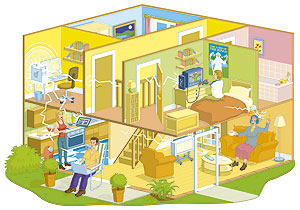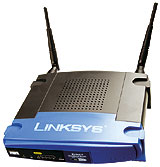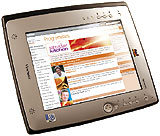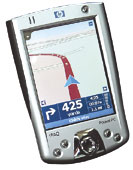Wire FreeFree your computer from the confines of the study with a wireless network These days, a home computer is far more than a trusty office tool; it may also be your photo album, sound system, movie player, games console, communications system and much more. Yet we keep all that power locked away in a back bedroom or study - hardly the ideal place to listen to music, play movies or view your holiday snaps. On the other hand, who wants a big grey box gathering dust in their living room? Thankfully, wireless technologies, such as Bluetooth and Wi-Fi, make it possible to access anything stored on your computer without leaving a trail of unsightly cables and sockets in your wake. Read on to find out how you can make wireless technology work for you. |
In Other Words
Ethernet
Local area network - LAN
Network
Port
Router
Wi-Fi hotspot |
The Technical BitThe term wireless encompasses a world of different devices - from remote controls to wireless routers and media adapters - all of which transmit data over the airwaves at certain frequencies just like a normal radio. Wireless technologies like Wi-Fi and Bluetooth (see January 2004) require both a transmitter and a receiver to work and these form the basis of a wireless 'network'. A home network can be as simple as connecting a laptop and desktop PC so you can access the internet from the living room, or as complex as five or six computers linked to each other via a routing device. While Wi-Fi is perfect for creating this kind of network, Bluetooth is better suited to one-to-one conversations between devices in close proximity to each other - a printer and your computer, say. On TestWe tested 12 very different wireless products to give you a taste of what's available and the best devices for a range of uses. If you've ever wanted to listen to your MP3 collection from the couch, view holiday snaps on your TV, look up online recipes in the kitchen or even surf the web from your local pub, there's something in our test selection to suit. We paid close attention to ease of set-up and use - building a wireless network takes time and patience, but it shouldn't require a degree in network engineering. |
Wireless Essentials It helps to plan your network before you start
A router is the heart of any wireless (Wi-Fi) or wired (Ethernet) network. It's useful to think of it as a central telephone exchange - every networked device communicates via this central location. A wireless router connects to your computer, using an Ethernet cable or wirelessly, and converts files stored on it into radio signals in order to share them with other wireless devices. So installing a wireless router and adapter for your printer would allow you to share files between computers on the network, without cables. You can wireless-enable most home computing gear from laptops to printers and PDAs by installing a wireless card or adapter. |
Wireless RoutersWe tested two wireless routers - the Linksys Wireless-G Broadband Router (£85) and the Thomson Speedtouch 570 ADSL Router (£100), both of which can be used to share a broadband internet connection between two or more computers, wirelessly. To test the Linksys router, we plugged it into our main, desktop computer using one of four Ethernet ports at the back of the router and our broadband modem via the 'internet' port. This allows the computer to communicate with the modem via the router and any other wireless-enabled computer (within range) to share the ADSL connection. Refreshingly easy to install, the Linksys Router has simple to follow instructions. And once we'd fitted a wireless card to our laptop, it picked up the signal from the router immediately, enabling it to go online and share files between the two computers (once permission has been granted).
Key
Linksys Wireless-G Broadband Router
 Verdict
Features Overall 94% www.linksys.com |
Wireless Routers : IIThe Thomson ADSL Router, on the other hand, will probably suit people who don't have broadband yet, as it combines an ADSL modem with a built-in wireless router. Like the Linksys, it connects to your main PC via the rear Ethernet port - once connected any wireless device, such as our wireless-ready laptop, will be able to access it. However, the Thomson router wasn't as simple to install as the Linksys router because of its extra security measures. Without additional protection, Wi-Fi isn't a very secure way to transfer data - as with radio, any wireless device within range can pick up an unencrypted signal. And because wireless networks do away with cables, tech-savvy neighbours might decide to help themselves to your high-speed internet connection or even take a peek at your personal files. To set up a secure wireless network with the Thomson router, you'll need to install special software on the main computer and press the modem's security button to register each device as a legitimate part of the network. This system can be erratic - we tried three times before it recognised our wireless laptop. When we eventually got online some websites were blocked. Although we were eventually able to fix the problem with the help of Thomson, the process involved downloading a program from a website (which we couldn't access due to the faulty set-up of the router) and then editing one of the device's system files. For most people, this kind of solution is simply too hard.
Key
Thomson Speedtouch 570 ADSL Router
Verdict
Features
Value £££
www.speedtouchdsl.com |
Ethernet BridgesAn Ethernet bridge, like the Netgear WGE101 Wireless Ethernet Bridge (£86) links wired (Ethernet) and wireless devices in order to get standard computing gear to communicate wirelessly. So connecting a Sony PlayStation 2, say (which has an Ethernet port but no wireless connection) to an Ethernet bridge should enable it to access a wireless router, allowing you to challenge opponents to games online. The Netgear Bridge's instructions were easy to follow. The first step is to plug the console (or another Ethernet device) into the Netgear Bridge and run the installation CD. Once installed, the bridge should display your existing wireless network. In our case, this comprised the Linksys router, DLink CardBus Adapter and, at times, the Linksys Media Adapter. Unfortunately, our attempts to get the Netgear Bridge to talk to the Linksys router, which would have allowed us to play games online using the PS2, were unsuccessful. Several calls to Netgear's helpline, adjusting our settings and a replacement device all failed to solve the problem. Eventually, Netgear admitted that it was 'possibly' the result of incompatibilities between Netgear and Linksys products. As the Linksys router and Netgear Bridge are based on the same Wi-Fi technology, there's no good reason for them not to talk to each other. Anecdotal evidence such as our own experience, however, suggests otherwise. Netgear WGE101Wireless Ethernet Bridge Verdict |
BluetoothBluetooth is a wireless technology more suited to intimate connections than fully-fledged networking. But as long as the devices are within a 10m radius of each other, it's ideal for connecting a computer to a printer, your PDA to your computer or a mobile phone to a hands-free headset. We tested the Mitsumi USB WML-C52APR (£60), a Bluetooth Adapter or 'dongle' that plugs into your laptop's USB port, enabling it to connect to another Bluetooth device. Installation was easy and the process helpfully places a shortcut to 'My Bluetooth Places' on your desktop so you'll be able to easily find and connect the Bluetooth Adapter to other Bluetooth devices. We had no trouble transferring a 50Kb file from PC to PDA or printing a document; nor was the time it took to transfer the data or print noticeably longer than using a standard wired connection. Key Mitsumi USB WML-C52APR Bluetooth Media Adapter  Verdict
Features Overall 61% www.mitsumi.de |
Technology ExtensionYou won't need a BT engineer to install an extra telephone point with the One For All Wireless Telephone Extension Kit (£60), which converts your ordinary electrical sockets into phone points. The kit comes with a base and extension unit, both of which are adapter-type plugs with a phone socket in the back. The adapters plug into standard power points, allowing you to connect a handset just as you would with a normal phone jack. The kit works well when used to make normal phone calls, however, if you'll be using the extra extension in order to dial-up to the internet, your connection speed will drop from 45 to 33 kilobits per second - a fact that is highlighted on the box. As such, the solution this kit provides is probably outdated in a broadband age. Key One For All Wireless Telephone Extension Kit Verdict
Features Overall 63% www.maplin.co.uk |
Home EntertainmentMany of us store music and video on our computers, but would prefer not to play them back on the tiny, built-in speakers or 15-inch screen of a standard PC. Both the Linksys WMA11B Wireless Media Adapter (£120) and Centrex Linkmaster LM3000 (£200) solve this problem by piping digital multimedia files from your computer into the living room. Together they represent a new breed of product called 'digital audio receivers' which pundits say will play an increasingly important role as the popularity of digital music grows and home networks become more widespread. The Linksys Media Adapter links your computer with your TV and stereo using Wi-Fi (IEEE 802.11), a wireless standard that transmits files over the airwaves. The adapter plugs into your TV and/or stereo and acts as a wireless receiver of media broadcast from your computer. But to work, it also needs a transmitter at your computer's end of the network to send the files in the first place. We attached a router to our computer to fulfil this function, but you could also use a 'wireless access point', 'bridge' or an internal wireless network card to connect the Media Adapter directly to a PC if you don't want or need a full home network. Unless the PC is fitted with a wireless card, the wireless router must be physically plugged into your computer. That said, it's wire free in the sense that it converts digital information (MP3 files, for instance) into a wireless signal that can be received by the Media Adapter at the other end. The Media Adapter then sends them along its cables to your TV or stereo and plays them back as normal. The Linksys Media Adapter came with step-by-step instructions making it very easy to install. And it proved an effective way of playing music or displaying photos from a remote computer without resorting to cables. The one limitation is that its relatively slow transfer rate means it's not really fast enough to stream video. |
Home Entertainment : IICentrex takes a very different approach to the same task with its Linkmaster system. The first step is to connect the 'Linkbox' to your computer's sound and video ports. This pipes digital music and audio files in analogue form along a length of aerial cable to another box called a 'coupling filter' that connects to your TV aerial; in effect, the Linkmaster system creates another channel on your TV that plays audio and video files from your computer. One rather significant downside is that it's only capable of playing music in mono, which somewhat defeats the point of streaming the files to the higher quality sound system in your living room. In addition, setting up the Linkmaster was harder than the Media Adapter as we had to knit together the Linkbox, coupling filter and 15m of cable which connects the Linkbox to your TV. In the end, the only wireless thing about the Linkmaster turned out to be its remote control. Verdict Despite being fast enough to handle video, the Linkmaster represents an overly complicated solution that will challenge even the most technically proficient consumers. Moreover, it fails to deliver on the promise of wireless. Centrex Linkmaster LM3000 | Linksys WMA11B Media Key Centrex Linkmaster LM3000
Features Overall 50% www.centrexonline.co.uk/linkmasterhome.asp top
Linksys WMA11B Media
Features Overall 85% www.linksys.com |
Wireless PeripheralsYou don't need to be a computer geek to see the benefits of wireless technology. Even the simplest devices like wireless keyboards and mice can make computing easier, and with a Tablet PC you can throw away your keyboard entirely and still surf the web from any room in the house. Wireless InputA cordless keyboard and mouse, such as the Microsoft Wireless Optical Desktop Elite (£57) not only reduces the clutter on your desk, it can also make computing more comfortable. Like most cordless keyboards and mice, the Elite uses Radio Frequency (RF) to talk to your computer. A receiver plugs into the back of your PC where you'd normally attach these peripherals, and converts RF signals from the keyboard and mouse into standard digital data. We had no problems setting up the Elite devices and their good results in our interference tests mean you shouldn't have any problems using it in combination with other wireless gear. The keyboard and mouse also have Microsoft's Tilt Wheel technology that enables horizontal as well as vertical scrolling, which proved useful for viewing large spreadsheets. It feels a bit unnatural at first - you'll need to spend time getting used to the changes. That said, it's easier to use on the keyboard than the mouse, as the wheel is slightly larger. Key Microsoft Wireless Optical Desktop Elite  Verdict
Wireless Overall 93% www.microsoft.com/hardware |
Wireless Peripherals : IIDigital notepad Tablet PCs are handheld, touch-operated computers that run a special version of Windows. Although they can be used as a standalone product, ideally they're designed to form part of a network. And as such, the Viewsonic V1100 Tablet PC (£760) has both an Ethernet port - to connect to a standard wired network - and Wi-Fi (802.11b) so you can look up internet recipes from the kitchen table, answer email in front of the telly or simply roam from room to room without dropping your connection. We connected to our existing wireless network without any problems and were able to go online via the Thomson ADSL router. Resembling an oversized personal digital assistant (PDA) with more computing power, the Viewsonic V1100 has a Pentium III 866MHz processor and 256Mb Ram. Like a PDA, it also has handwriting recognition, which you can only use with the supplied stylus. Its action feels unusual at first and requires practice, particularly as the cursor starts to move as soon as the stylus approaches the screen. You can also connect a keyboard to the Tablet PC via the USB port. The V1100 has a 10.4in LCD screen, which is adequate for viewing ebooks (using the supplied software) and playing slideshows of digital photos. However, at 1563g, it was a little heavy to hold and its back became warm after prolonged use. Key Viewsonic V1100 Tablet PC  Verdict
Features Overall 74% www.viewsonic.com |
Freedom to RoamThe beauty of wireless is that you're not tied down to a single spot and it's just as effective outside as inside your home - provided you stay within range. And while a laptop is portable by the emergence of Wi-Fi hotspots in pubs, cafés and trains across the country means that with the right equipment, you can now get online from a variety of public places. We went out-and-about with a wireless laptop, Bluetooth headset and an in-car navigator to see whether wireless technology on the go lives up to the hype. Wireless On the CardsSome modern laptops have wireless-ready processors like Intel's 'Centrino' chip. Some also come with a wireless card pre-installed. But, if your laptop has neither, you can install a wireless PC Card like the D-Link AirPlusXtremeG DWL-G650 Wireless CardBus adapter (£53) into one of your laptop's PCMCIA slots to achieve the same effect yourself. We installed the D-Link adapter in a Windows XP laptop with relative ease and as soon as we ran the installation CD, the card recognised our wireless network and asked us if we wanted to connect. Tracking down a Wi-Fi hotspot close to our lab at which to test the now wireless ready laptop wasn't easy - they're not currently as widespread as some ads may have you believe - but eventually we found a local Starbucks that offered a service. Launching Internet Explorer was all we needed to do to access the service - a welcome page explained that we could buy an hour's connection by credit card for £5.50. Key D-Link AirPlusXtreme G+ DWL-G650  Wireless Card Bus Adapter  Verdict
Features Overall 88% www.dlink.co.uk |
Freedom to Roam : IIHeads UpAs most of us are aware, it's now illegal to use your mobile phone while driving. A Bluetooth headset, like the Plantronics M3000 (£55), and phone will allow you to talk and drive at the same time, without wires tying you up in knots. Establishing a link between it and a compatible mobile phone was reasonably easy and the headset has four intuitive buttons for making and receiving calls, adjusting the volume and muting a call. Unfortunately, the M3000 was uncomfortable and our tester complained of pain in the earlobe after just 20 minutes wear. Key Plantronics M3000 Bluetooth Headset  Verdict
Features Overall 54% www.plantronics.com |
Freedom to Roam : IIIOut And AboutThe TomTom Navigator 2 (£352) is a mobile navigation system designed for avoiding traffic and finding your way from 'A' to 'B'. It sits in your car or hand, and receives signals via its global positioning system (GPS), which can locate you within a few metres. It connects to a PDA, which you'll also need to display the TomTom maps, via Bluetooth. Once installed, the satellite navigation system identifies your current position on these maps and plots a route between you and your destination. While connecting the TomTom to our PDA was straightforward, it is tailored to specific models of PDA so you'll need to make sure your PDA is compatible before you buy. Maps come in a variety of regions, allowing you to load only those areas you need, and save space on your PDA. The Navigator sits on the dash of your car where it can easily receive GPS signals. In 'navigator' mode, the device issues voice prompts when your exit approaches so you aren't distracted by looking at the screen. The device's Bluetooth connection gives you more freedom over where to place the TomTom and your PDA than previous versions which plugged into the PDA and cigar lighter in your car. Key TomTom Navigator 2   Verdict
Features Overall 90% www.tomtom.com |
Trouble-free NetworkingHere are a few general tips that will help you on your way to creating a trouble-free wireless network.Plan aheadAsk yourself why you want a wireless network and think about the best ways to achieve it. Then sketch out which devices will need to connect to each other. Choose compatible componentsOnce you know which networking devices you'll need to buy, try to source them from a single manufacturer to minimise the risk of incompatibilities. Create a wired connection firstOnce you're ready to build your network, start by connecting those devices that need to be plugged in. For example, plug your computer into the wireless router first, so you'll know if all the core components of the network - in this case the router and your PC - are working properly before you start adding wireless devices such as a wireless-ready laptop. Read the instructionsCreating a wireless network is more complex than building flat-packed furniture (honest). So read the instructions carefully and follow them to the letter, in the order they are written. |